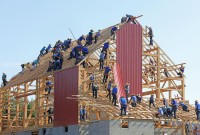- Home
- Business Processes
- Industry Knowledge
- Aerospace Industry
- Automotive Industry
- Banking Domain
- BFSI Industry
- Consumer/ FMCG Industry
- Chemicals Industry
- Engineering & Construction
- Energy Industry
- Education Domain
- Finance Domain
- Hospitality Domain
- Healthcare Industry
- Insurance Domain
- Retail Industry
- Travel and Tourism Domain
- Telecom Industry
- Leadership Skills
- eLearning
- Home
- Leadership
- Leadership Theories
- Behavioral Approach to Management
Behavioral Approach to Management
The behavioral management theory had a profound influence on management by focusing on understanding the human dimensions of work. It is also called human relations movement as behavioral theorists focused on managing productivity by understanding factors of worker motivation like their needs and expectations, personality, attitudes, values, group behavior, conflict, and group dynamics. It advocated the use of psychological techniques to motivate employees.
The behavioral school of management emphasized what the classical theorists ignored which is the human element of the workplace. While classical theorists only viewed the organization from a production perspective, the behavioral theorists also focused their study on an individual’s attitudes, behaviors, and group dynamics in the workplace culture.
Hawthorne Studies
The behavioral approach emerged primarily as an outcome of the Hawthrone studies. Many Parke Follet, Elton Mayo, and his associates, Abraham Maslow, Douglas MCgradgor, and Chris Angyris were the major contributors to this school. As part of these studies, the researchers concluded that the workers worked harder because they thought that they were being monitored individually.
This study established the behavioral change that happened due to an awareness of being observed, resulting in active compliance with the supposed wishes of researchers, because of special attention received, or positive response to the stimulus being introduced.
Elton Mayo's experiments showed an increase in worker productivity was produced by the psychological stimulus of being singled out, involved, and made to feel important. Researchers hypothesized that choosing one's own coworkers, working as a group, being treated as special, and having a sympathetic supervisor were the real reasons for the productivity increase.
One interpretation was that "the six individuals became a team and the team gave itself wholeheartedly and spontaneously to cooperation in the experiment. Hawthorne Effect can be summarized as “Employees will respond positively to any novel change in a work environment like better illumination, clean work stations, relocating workstations, etc. Employees are more productive because they know they are being studied.
These findings made Mayo and Roethlisberger conclude that a leader has not only to plan, decide, organize, lead, and control but also consider the human element. This includes the social needs of being together and being recognized for the work interaction of the group members with each other and their wellbeing. A good leader ought to keep the above aspects in his style of working with people and supervising their work.
Maslow's Hierarchy of Needs
Abraham H Maslow (1908-1970), the psychologist, theorized that people were motivated by a hierarchy of needs. Maslow (1943) focused on human needs. Maslow's hierarchy of needs is a motivational theory that explains that people are motivated by five basic categories of human needs. These needs are physiological, safety, love and belonging, esteem, and self-actualization.
His theory rested on three assumptions:
- All of us have needs which are never completely fulfilled
- Through our acts, we try to fulfill our unsatisfied needs
- Human needs occur in the following hierarchical manner:
- Physiological needs;
- Safety or security needs,
- Belonging needs or self-fulfillment needs
According to Maslow, once needs at a specific level have been satisfied, they no longer act as motivators of behaviors. Then the individual strives to fulfill needs at the next level. Managers who accepted Maslow's hierarchy of needs attempted to change their management practices so that employees' needs could be satisfied.
This theory established the principle that a leader's behaviors can be conditioned in a manner that one can have a specific response to specific stimuli. The behavioral theory promotes the value of leadership styles with an emphasis on concern for people and collaboration. It promotes participative decision making and team development by supporting individual needs and aligning individual and group objectives.
It helps managers evaluate and understand how their behavioral style as a manager affects their relationship with the team and promotes commitment and contribution towards organizational goals. This theory helps managers find the right balance between different styles of leadership, and helps them decide how to behave as a leader, depending on concerns for people and for productivity.
Suggested Reading and Resources
Related Links
You May Also Like
-
The best career choices are ones that match your values. Each person has several values that are important to him. These values are highly personal and knowing them provides a clearer sense of what's most important to you in your life and career. Career values are the beliefs you consider important from a work standpoint. Values help you understand what you want from a job? Explore a few examples of work values that can influence career path and job satisfaction.
-
Teams are part of the modern organizational culture. Whether you are a team leader or a team member, having a better understanding of how teams work, and being able to identify where the team is in the process, is a critical part of ensuring the team is ultimately successful. Start with the basics and understand what a team is and what role they play in an organization.
-
Frederick Winslow Taylor started the “Scientific Management Movement”, and attempted to study the work process scientifically. Scientific management, also called Taylorism, was a theory of management that analyzed and synthesized workflows. It is a system for increasing the efficiency of manpower to its maximum potential and streamlining production to improve efficiency. This article explores this theory in more detail.
-
Hawthorne Studies - Leadership
The Hawthorne studies were conducted on workers at the Hawthorne plant of the Western Electric Company by Elton Mayo and Fritz Roethlisberger in the 1920s. This study established the behavioral change that happened due to an awareness of being observed, resulting in active compliance with the supposed wishes of researchers, because of special attention received, or positive response to the stimulus being introduced.
-
Emergent leadership occurs when a group member is not appointed or elected as leader, but rather that person steps up as the leader over time within-group interactions. Have you ever faced challenges in getting accepted into your new role of position as a leader? Groups don't automatically accept a new "boss" as a leader. Emergent leadership is what you must do when taking over a new group. Learn more about emergent leadership.
-
Theory Z also called the "Japanese Management" style is a leadership theory of human motivation focused on organizational behavior, communication, and development. It assumes that employees want to enter into long term partnerships with their employers and peers. Offering stable jobs with an associated focus on the well-being of employees results in increased employee loyalty to the company.
-
Certain generally accepted truths or principles of communication are important to consider when communicating with others. These principles hold true for all people in every culture. By understanding these principles, you will experience greater communication effectiveness. An effective communication system is one that achieved its objectives. Communication is effective where there are no barriers to communication.
-
Quantitative Theory of Management
The quantitative management approach is given by the mathematical school that recommends the use of computers and mathematical techniques to solve complex management issues and assist in the managerial decision-making process. Managers observe historical quantitative relationships and use quantitative techniques such as statistics, information models, and computer simulations to improve their decision making.
-
Modern Approaches to Management
The modern approaches to management look at organizational management in the current context. They take a holistic approach and look at organizations as a collection of interrelated parts influenced by both internal dynamics and also the larger external environment. These modern management theories have played a significant role in the evolution of management studies.
-
Team leadership theory is a recent leadership theory that does not discriminate between the leader and the other team members. The approach considers contributions from each team member to be critical for organizational success. This approach focused on the overall team effectiveness and team problems are diagnosed and action is taken to remediate weakness. This approach provides for taking corrective action when the leader deems necessary.
Explore Our Free Training Articles or
Sign Up to Start With Our eLearning Courses

About Us
Learning
© 2023 TechnoFunc, All Rights Reserved










